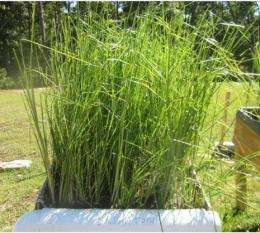Getting the lead out

About 250,000 children in the United States have high levels of lead in their systems, say the Centers for Disease Control. Children under the age of 6 are especially vulnerable to lead poisoning, which can severely affect mental and physical development. At very high levels, lead poisoning can be fatal.
Most people know that old paint (from before 1978) can contain high amounts of lead and that children can be poisoned by ingesting paint flakes. But that paint can also slough off into neighboring soils, creating a hazard for gardeners—and children playing in the dirt.
Now, a biologist at Michigan Technological University is working on a way to remove lead from soil that is simple, inexpensive, and, quite literally, green.
Rupali Datta began her tests with vetiver grass back in 2004, when she was on the faculty of the University of Texas at San Antonio. “The city was removing lead paint in an old neighborhood, but there was still lots of lead in the soil,” she remembers. “The soil was tracked in the house as lead-laced dust.”
Datta and her colleague Dibs Sarkar, now a professor at Montclair State University in New Jersey, brought soil from the neighborhood into a greenhouse and planted it with vetiver grass. To make the experiment more interesting, she also planted vetiver on contaminated soil imported from Baltimore, which has acidic soil; San Antonio’s dirt is alkaline.
Vetiver is a clump-forming, perennial grass native to India. It is grown throughout the tropics for its fragrant essential oil, but it has many other uses and can tolerate high levels of contaminants, including heavy metals.
Datta and Sarkar found that vetiver not only tolerated the lead from San Antonio and Baltimore, it also absorbed it, slashing the levels in soil. They are now working on a larger project in New Jersey and Texas, which began last August. They planted vetiver outside in plywood planter boxes filled with contaminated soil.
“The plants are growing really well,” Datta says. The researchers have cut the vetiver back and are beginning their analysis. The soil samples originally contained between 1,200 and 1,600 milligrams of lead per kilogram, three to four times the maximum amount deemed safe. “Based on our earlier work, I think we’ll have to grow eight cycles to remediate 1,200 milligrams per kilogram to 400 milligrams,” Datta estimates.
That could take up to eight years, though no replanting would be necessary--the vetiver sends out new shoots from its roots--but the advantages are still substantial. “Homeowners could do the remediation themselves,” she said. The vetiver will contain lead, but it will be bound up in the plant, not in dirt or dust that could be accidently ingested.
The cut grass (and lastly its roots) could then be landfilled in a hazardous waste facility, or even incinerated. “This process really reduces the volume of the waste,” Datta said. “You would have 1/100th the amount of the original contaminated soil to dispose of.”
Datta’s team is compiling results from the field study and expects to publish them later in the year. The next step will be to test vetiver at an actual contaminated site, and she is also curious about whether or not the lead will leach out of the vetiver after its harvested.
While vetiver may prove to be a great tool for lead remediation, this subtropical plant won’t grow everywhere.
“I assume it will die in Houghton, unless the snow cover provides natural insulation,” Datta says, but maybe something else will clean up northern soils. “For the UP, I’d like to look at other plants, like miscanthus.”
Provided by Michigan Technological University















